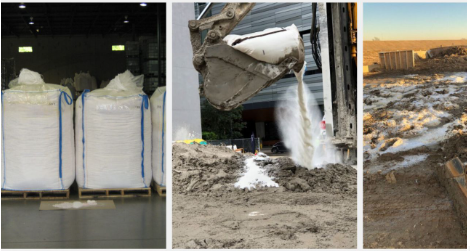EDUCATION
Biodegradable Super Absorbent Polymers: A Green Solution for Water Conservation

With the water crisis looming large in almost every nation in the world, creative solutions are required to manage and save this precious natural resource. In this direction, biodegradable super absorbent polymers (SAPs) have come to a promising green technology. Not only do these polymers provide environmental benefits, but also, they offer several significant advantages in the agricultural and industrial sectors. Get a deep understanding of biodegradable super absorbent polymer in multiple domains. The current article discusses the water-retention capability of biodegradable SAPs, their environmental consequences, and various categories where they can be used.

Biodegradable Super Absorbent Polymers
Biodegradable super absorbent polymers — These materials can absorb and hold quantities of liquid many times that if their weight. This reinforcer is a fully biodegradable SAP, which means it will degrade in the environment releasing all trapped particles inside, unlike traditional SAPs that can stay functional for long periods. They are polymers that break down into non-toxic, biodegradable byproducts to improve the environment and prevent long-term pollution.
Advantages in Agriculture for Water Conservation
In agriculture, water conservation is very important to maintain crop yields and sustain long-term farming practices. SAPs and other biodegradable super absorbent polymers have a significant contribution potential here, in terms of increasing the retention capacity for soil water. These polymers can absorb water during irrigation or rainfall and retain it in the soil by slowly releasing whatever they have. This means irrigation need not be carried out as frequently, which helps save water and lowers the total water footprint resulting from farm work. Biodegradable SAP also improves soil structure and plant growth, aiding in better harvest while decreasing the use of chemical fertilizers.
Prevention of Soil Erosion and Compaction
One of the leading problems in agriculture and land management is soil erosion, followed closely by compaction. The most effective route to try and solve these problems was through using a biodegradable super absorbent polymer that would help in soil stabilization as well as the improvement of its structure. If you apply these polymers to soil, they help in keeping the water and that reduces runoff soil erosion problem. Additionally, with the higher moisture present compaction of soils that can hurt root development and water movement through the soil profile is swelling prevention. Biodegradable SAPs minimize erosion and compaction, which results in generally healthier soils that support stronger ecosystems.
Examples Include Urban Landscapes and Green Spaces
Biodegradable super-absorbent polymers also help contribute to the cleanliness of urban areas and green spaces. Moreover, given that space and water resources are often limited in cities, these polymers can be used for landscaping or green infrastructure projects. The technology can be made into plants and soil-like materials to create a greener, more sustainable urban environment. Water usage is saved by integrating biodegradable SAPs in the form of vegetation or on green roofs which could cut back considerably on irrigation needs as shown right here for three crop plants grown under controlled circumstances; decreasing general evaporation items restrict available water only gradually. These cure and become gels that absorb water, like the polymer in baby nappies; they release their moisture over time too so contribute to keeping garden soil moist.
Industry Applications and Wastewater Treatment
Biodegradable SAPs are employed to regulate waste and manage water across many industrial uses. In such a way in construction, they can be used to stabilize and protect the material, for example, concrete from excess moisture. The best use of biodegradable SAPs is in waste management to help solidify liquid waste so it can be managed and disposed of easily. This water-absorbing and retaining capability of these polymers can be used in controlling the waste impact on different industrial scales. Due to their biodegradable property, they do not add to the environmental waste cause which in sustainable development is an area of focus.
Sustainability and Environmental Effects
Biodegradable super absorbent polymers have significantly less environmental impact than traditional plastic-based SAPs. These polymers degrade into non-toxic products which do not add to the accumulation of plastic in nature or endanger any living organism. Besides the sustainable nature of biodegradable SAPs, their production often also requires renewable resources and environmentally friendly manufacturing processes. Biodegradable SAPs, advance the environmental and sustainable agendas by diminishing dependence on traditional plastics while providing efficient water management.

Challenges and Considerations
While biodegradable super absorbent polymers hold promise, we should not overlook their challenges. This has been an ongoing debate concerning how they cater to outperform and longevity in contrast to the conventional SAPs. Although biodegradable polymers present environmental advantages, they have irrigation water absorption and retention performance that is below those of conventional materials. In some cases, the degradation rate of biodegradable SAPs is dependent on environmental conditions that may reduce and slow down its overall efficiency in such applications.
Upcoming Opportunities and Innovations
The interest and development capacity for biodegradable super absorbent polymers is hoped to be promising with further advances in material science. Scientists are working on new compositions and manufacturing methods to improve the properties of these polymers (i.e. performance, and biodegradability). Innovation is looking to make SAPs with increased water absorbency, biodegradation rate, and wider applicability. The increasing demand for environmentally friendly and sustainable solutions will be met with the development of biodegradable SAPs that are expected to resolve most challenges related to water conservation, irrigation issues, and environmental concerns.
Conclusion
The development of biodegradable super absorbent polymers could be a game changer in the fight for water conservation and environmental sustainability. Its high water holding and retention capacity, combined with being biodegradable makes SAP very valuable for agriculture as well as urban landscapes alongside their industrial applications. Biodegradable SAPs, thus have the potential to be an environmentally benign solution that is eco-friendly and aligned with green chemistry principles of sustainability goals through water efficiency, erosion prevention as well as plastic pollution management. Biodegradable super absorbent polymers can offer a significant improvement to water conservation and environmental well-being but are limited by current technology.
EDUCATION
Nomurano: Exploring the Story, Meaning, and Modern Relevance

Nomurano is a name that carries a sense of mystery and elegance. For some, it sounds like it could belong to a luxury brand; for others, it feels like the title of a place in an undiscovered story. Regardless of its interpretation, Nomuranos has started to appear in conversations about design, marketing, and creative identity.
In this guide, we will explore the possible origins of Nomuranos, its role in different industries, and why it resonates with modern audiences.
Where Does Nomurano Come From?
Unlike traditional names tied to a single culture, Nomurano doesn’t have one fixed history. This gives it flexibility and a global charm.
Some believe Nomuranos could be a blended term inspired by multiple languages, while others see it as a completely invented name designed to stand out. Because of this open-ended nature, it has the ability to fit into many different contexts.
Nomurano in the World of Branding
In business, the right name can mean the difference between being forgotten and being remembered. Nomurano has the advantage of sounding unique, yet familiar enough to be easy to say and recall.
Why Companies Choose Nomurano
Brands that want to signal sophistication and forward-thinking ideas are often drawn to names like Nomurano. Its smooth syllables, modern tone, and lack of rigid meaning allow it to grow with a company’s evolving identity.
A Versatile Brand Asset
Nomurano can be used for a fashion label, a tech startup, a high-end café, or even a luxury travel agency. This adaptability is one reason it’s appealing to entrepreneurs.
Nomurano in Creative Arts
Nomurano has also found its way into creative fields such as literature, design, and visual media.
As a Symbol in Storytelling
Writers might use Nomurano as the name of a fictional city, an exclusive club, or a central character. Visual creators could feature it as part of an art series or collection, giving the name new meanings through their work.
Digital Visibility of Nomurano
In today’s world, a name’s presence online can shape its success. Nomurano has the benefit of being relatively rare, making it easier to stand out on search engines and social media.
SEO and Nomurano
From a search optimization perspective, Nomuranos is a low-competition keyword. With the right strategy, content or brands using this name could quickly rise in rankings.
Growing Social Media Appeal
On visual platforms like Instagram and Pinterest, Nomurano is slowly appearing as a hashtag for design projects, boutique launches, and lifestyle inspiration.
Lifestyle and Cultural Associations
Nomurano is increasingly being linked with elegance, minimalism, and a global mindset. It carries an air of refinement that appeals to audiences seeking something modern but timeless.
A Reflection of Contemporary Taste
Whether it’s a fashion collection, interior décor theme, or a travel experience, the Nomurano name fits into settings that value quality, style, and uniqueness.
The Challenge of a Flexible Name
While flexibility is a strength, it can also be a challenge. Without a defined cultural anchor, Nomuranos can mean different things to different people.
Consistency in Use
For brands and creators, the key is to maintain a consistent story around Nomuranos. This ensures the name develops a recognizable personality rather than being interpreted in too many unrelated ways.
Future Potential of Nomurano
As the world becomes more connected, distinctive names with international appeal are likely to grow in value. Nomurano’s neutral yet stylish tone positions it well for future opportunities.
Predictions for Growth
We might see Nomurano linked to luxury collaborations, exclusive experiences, and high-end digital projects. Its adaptable nature means it can move between industries without losing its charm.
Conclusion
Nomurano is more than just a word — it’s a flexible, globally appealing identity that can be shaped by the people and brands who use it. Whether in business, art, or lifestyle culture, it offers a rare combination of uniqueness and adaptability. As trends continue to favor names that stand out and resonate across borders, Nomurano is set to leave a lasting mark.
EDUCATION
Tran Ny Tube: Everything You Need to Know

In the ever-changing digital landscape, new trends emerge quickly, shaping how people interact online. One such rising keyword is tran ny tube, which has become a topic of curiosity across forums, blogs, and social platforms. Whether you’re a casual internet user, a content creator, or someone interested in digital marketing, understanding tran ny tubes can provide valuable insights.
What Does Tran Ny Tubes Mean?
Although still relatively new, tran ny tube refers to an online trend associated with digital communities and content-sharing spaces. People use the phrase to explore fresh content, engage in discussions, and discover innovative online experiences. Its growing visibility indicates that tran ny tubes is more than just a passing phrase—it’s becoming part of the broader conversation about internet culture.
Why Tran Ny Tube is Trending
The popularity of tran ny tubes can be explained by several factors:
-
Novelty – Many users are drawn to new and unusual terms, making tran ny tube an intriguing subject.
-
Community Impact – Online groups have begun using the term to share ideas and content.
-
Search Growth – More people are typing “tran ny tubes” into search engines, giving it higher visibility.
-
Adaptability – It fits into different types of content, from entertainment to education.
This combination has pushed tran ny tubes into the spotlight, making it a keyword worth watching.
Features That Make Tran Ny Tube Unique
Unlike ordinary digital terms, tran ny tube stands out for its adaptability and wide appeal. Some of its key features include:
-
Global Reach – Accessible to users worldwide.
-
Diverse Content – Ranging from informative posts to creative entertainment.
-
Interactive Nature – Encourages discussions and participation.
-
Search Potential – Acts as a keyword for SEO-focused content creators.
These qualities give tran ny tubes a unique position in the online ecosystem.
The Role of Tran Ny Tubes in Online Communities
Communities thrive on connection, and tran ny tube has begun serving as a bridge for like-minded individuals. Forums, social media pages, and blogs dedicated to digital culture often highlight tran ny tubes, making it a topic of discussion. This not only boosts its popularity but also helps build micro-communities centered around curiosity and shared interests.
Applications of Tran Ny Tube in the Digital World
While the phrase may seem abstract, tran ny tube has practical applications across multiple fields:
-
Education – It can be used to introduce new learning methods and resources online.
-
Entertainment – From video sharing to interactive media, tran ny tubes adds value to creative content.
-
Digital Marketing – Businesses are exploring tran ny tubes to attract niche audiences.
-
Trend Analysis – Researchers study it to track emerging online behaviors.
By blending practicality with trend appeal, tran ny tubes continues to expand its relevance.
SEO Benefits of Using Tran Ny Tube
For digital marketers and website owners, tran ny tube is more than a buzzword. It’s also an opportunity to capture organic traffic. Incorporating this keyword into blogs, articles, and social content can help:
-
Improve search engine rankings.
-
Drive targeted visitors to websites.
-
Build authority in niche markets.
-
Strengthen engagement with trend-focused audiences.
When used strategically, tran ny tubes offers a fresh path for SEO growth.
Why People Are Drawn to Tran Ny Tube
Beyond its marketing potential, tran ny tube taps into human curiosity. People want to understand new digital phenomena, and the mystery behind the phrase keeps users engaged. Moreover, its ability to connect different types of content—from serious topics to fun and casual discussions—ensures its appeal spans across demographics.
The Future of Tran Ny Tube
Looking forward, tran ny tube is expected to keep evolving as digital spaces change. With technology advancing rapidly and online communities expanding, the term could take on new meanings and applications. Whether as part of SEO strategies, social media discussions, or educational tools, tran ny tubes is likely to remain relevant for years to come.
Conclusion
The rise of tran ny tube proves how quickly digital trends can shape online conversations. From its role in building communities to its importance in SEO and marketing, the term has shown remarkable versatility. As the internet continues to grow, keeping an eye on tran ny tubes can help individuals and businesses stay ahead of the curve.
EDUCATION
The Ultimate Guide to Überzetsen: Everything You Need to Know

Are you ready to embark on a linguistic adventure? Today, we’re diving into the fascinating world of “Überzetsen” – a German verb that holds immense power in the realm of translation. Whether you’re an aspiring polyglot or simply curious about different languages, this ultimate guide will equip you with everything you need to know about überzetsen.
In this blog post, we’ll unlock the meaning and nuances behind überzetsen in German. We’ll explore its various translations in different contexts and delve into some popular German verbs that can enhance your language skills. Get ready to immerse yourself in conjugation forms, as we uncover how to use überzetsen effectively in your conversations.
So grab your dictionary (or open up that translation app), because it’s time to unravel the mysteries of überzetsen! Let’s dive right in and discover the beauty of language through this extraordinary word.
Understanding Überzetsen in German
Understanding Überzetsen in German may seem like a daunting task, but fear not! With a little guidance and some practice, you’ll soon be able to grasp this unique word. So, what exactly does Überzetsen mean?
In German, Überzetsen is the verb form of “to translate.” It encompasses the act of rendering text from one language into another. Translation plays a crucial role in bridging language barriers and facilitating communication between different cultures.
When it comes to understanding Überzetsen in different contexts, it’s important to consider the specific nuances and connotations associated with translation. Whether it’s translating literary works or technical documents, each context requires its own approach and expertise.
To truly comprehend how to use Überzetsen effectively, familiarizing yourself with popular German verbs is essential. Verbs like lesen (to read), schreiben (to write), sprechen (to speak), and verstehen (to understand) are frequently used alongside Übersetzen to convey various linguistic activities.
By delving into the indicative conjugation of Überzetsen – using forms such as ich übersetze (I translate), du übersetzt (you translate), er/sie/es übersetzt (he/she/it translates) – you can begin forming basic sentences that express your translation skills.
Now that we’ve explored understanding Überzetsen in German, let’s dive deeper into other aspects related to this versatile verb. From subjunctive conjugation for hypothetical situations to imperative forms for giving commands or requests – there’s much more discover on your journey towards mastering this fascinating word!
Translating “Überzetsen” in Different Contexts
When it comes to translating the word “Überzetsen” in different contexts, there are various factors to consider. The meaning of this German verb can change depending on the context in which it is used.
In a general sense, “Überzetsen” means “to translate.” However, its exact translation can vary based on the specific situation. For example, if you’re talking about translating a document or text from one language to another, you would use “Überzetzen.”
In a more figurative sense, “Überzetsen” can also mean to interpret or explain something. In this context, it implies going beyond just translating words and getting into the deeper meaning or interpretation of a text.
Another way that “Überzetsen” can be understood is as an act of transferring or conveying information from one source to another. This could apply not only to languages but also to other forms of communication such as art or music.
The versatility of “Überzetsen” makes it an important concept when it comes to understanding and communicating across different languages and cultures. Its multifaceted nature allows for flexibility in interpretation and translation processes. So whether you’re working with written texts or trying to bridge communication gaps between people from different backgrounds, knowing how to navigate the various meanings and uses of “Überzetsen” will prove invaluable
Popular German Verbs
German is known for its complex grammar and verb conjugations. In order to master the German language, it’s important to become familiar with some of the most popular verbs used in everyday conversation. These verbs will not only help you express yourself effectively, but also allow you to understand and participate in conversations with native speakers.
One commonly used verb in German is “gehen,” which means “to go.” Whether you’re talking about going to work, school, or simply going out with friends, this versatile verb will come in handy. Another useful verb is “sprechen,” which means “to speak.” With this verb, you can easily communicate your thoughts and ideas in German.
If you want to ask someone a question or request something politely, the verb “fragen” (to ask) is essential. By learning how to use this verb correctly, you’ll be able to engage in meaningful conversations and seek information when needed. Lastly, “machen” (to do/make) is a versatile verb that can be used for various actions such as cooking, cleaning, or even creating something.
These are just a few examples of popular German verbs that can greatly enhance your speaking abilities. By practicing these verbs regularly and using them within different contexts, you’ll quickly build confidence in your German language skills! So don’t hesitate – start incorporating these verbs into your vocabulary today!
Indicative Conjugation of “Überzetsen”
The indicative conjugation of “Überzetsen” is an essential aspect to understand when learning German. It allows us to express actions or states that are considered factual or certain. So, let’s dive into it and explore this conjugation in more detail!
In the present tense, “Überzetsen” follows a regular pattern. For example, in the first person singular, you would say “Ich überzetse,” meaning “I translate.” In the third person singular, it becomes “Er/sie/es überzetst,” which translates to “He/she/it translates.”
Moving on to the past tense, we use the auxiliary verb “haben” (to have) along with the past participle form of “überzetsen.” For instance, in the first person singular, you would say “Ich habe überzetst,” meaning “I have translated.”
When talking about future actions using Überzetsen, we can use either the present tense or auxiliary verbs like werden (will), similar to English. So you could say something like: “Morgen werde ich übersetzen” which means “Tomorrow I will translate.”
Remember that these examples only cover a few forms of indicative conjugations for Überzetsen. As with any verb in German language learning; practice is key! By regularly practicing and immersing yourself in conversations and texts where Überzetsen is used naturally; you’ll become more confident with its usage.
So keep exploring and expanding your knowledge of German grammar by delving deeper into different verb forms and tenses!
Subjunctive Conjugation of “Überzetsen”
The subjunctive conjugation of “Überzetsen” is an important aspect to understand in order to fully grasp the meaning and usage of this German verb. In the subjunctive mood, “Überzetsen” expresses hypothetical or unreal conditions, wishes, or doubts.
To form the present subjunctive, simply add an umlaut over the letter “e” in the stem of the verb: überzetse. For example, in a sentence like “I wish I could translate better,” you would use the present subjunctive form: Ich wünsche mir, dass ich besser überzetse kann.
In the past tense, we use “hätte” plus the past participle of Überzetsen to express actions that didn’t actually happen or are contrary to reality. For instance, if you wanted to say “If only I had translated that document correctly,” you would say: Wenn ich doch dieses Dokument richtig überzetst hätte.
In conditional sentences where there is a possibility but uncertainty about an action taking place in future time periods as well as expressing polite requests or suggestions back then too; it’s recommended using würde + infinitive instead of Subjuncitve II forms for convenience reasons.
Understanding how to properly use and conjugate verbs like Überzetsen can greatly enhance your German language skills. So practice with different scenarios and contexts until you feel confident with its various forms and meanings!
Imperative Conjugation of “Überzetsen”
The imperative conjugation of “Überzetsen” in German is an essential aspect to understand when learning this verb. It allows you to give commands or make requests in a direct and concise manner. Let’s delve into how the imperative form works for “Überzetsen.”
To form the imperative, simply drop the subject pronoun (du, ihr) and use the base form of the verb. For example, if you want to say “Translate!” to someone informally, you would simply say “Überzetse!” The same goes for addressing a group of people: “Translate!” becomes “Überzetst!”
When using more polite forms like Sie (formal ‘you’), it’s common to add bitte (please) before the verb. So, saying “Please translate!” would be expressed as “Bitte übersetzen Sie!”
It’s important to note that the imperative form does not change based on gender or number; it remains constant regardless of who you are speaking to.
With this understanding of how to use the imperative conjugation for “Überzetsen,” you can confidently express your translation needs or request others’ assistance with ease! Keep practicing and incorporating these phrases into your conversations for fluency in German communication!
Participle Forms of “Überzetsen”
In this ultimate guide to Überzetsen, we’ve explored the various aspects of this German verb and its translations. From understanding the meaning of Überzetsen in German to exploring its different contexts and popular verbs, we’ve covered it all.
Now, let’s dive into the participle forms of Überzetsen. The participle form is used to create compound tenses in German. For Überzetsen, the past participle is “überzetst” and the present participle is “überetzend.”
By using these participle forms along with helping verbs like haben (to have) or sein (to be), you can express actions that have happened or are happening in relation to Überzetsen.
Mastering Überzetsen opens up a world of possibilities for communication and understanding in German. Whether you’re reading a book, watching a movie, or having a conversation with native speakers, knowing how to use this verb will greatly enhance your language skills.
So go ahead and practice conjugating Übersetzen in different contexts. Immerse yourself in the language and embrace the beauty of expressing yourself through words!
Remember, language learning takes time and dedication. Don’t be afraid to make mistakes; they are an integral part of the learning process. With each step forward on your journey towards fluency, you’ll gain confidence and expand your linguistic horizons.
-

 GENERAL2 years ago
GENERAL2 years agoDiscovering the Artistic Brilliance of Derpixon: A Deep Dive into their Animation and Illustration
-

 Posts2 years ago
Posts2 years agoSiegel, Cooper & Co.
-

 Lifestyle2 years ago
Lifestyle2 years agoPurenudism.com: Unveiling the Beauty of Naturist Lifestyle
-

 HEALTH2 years ago
HEALTH2 years agoTransformative Health Solutions: Unveiling the Breakthroughs of 10x Health
-

 FASHION2 years ago
FASHION2 years agoThe Many Faces of “λιβαισ”: A Comprehensive Guide to its Symbolism in Different Cultures
-

 Lifestyle2 years ago
Lifestyle2 years agoBaddieHub: Unleashing Confidence and Style in the Ultimate Gathering Spot for the Baddie Lifestyle
-

 Entertainment2 years ago
Entertainment2 years agoGeekzilla Podcast: Navigating the World of Pop Culture, Gaming, and Tech
-

 Lifestyle1 year ago
Lifestyle1 year agoSandra orlow: Unraveling the Story of an Iconic Figure
